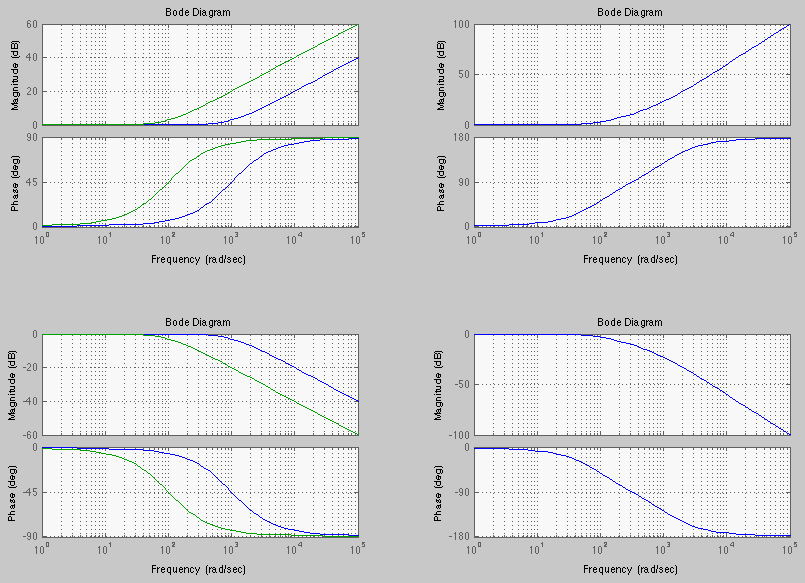Next: Bode Plots of first Up: Appendix Previous: Bode Plots

 (143)
(143)

 (144)
(144)
 :
:
 (145)
(145)
 ,
,

 becomes ten times higher, then
becomes ten times higher, then
 (146)
(146)
 is a straight line with a slop of 20 dB/dec that goes
through a zero-crossing at
is a straight line with a slop of 20 dB/dec that goes
through a zero-crossing at  .
.
Also consider two additional cases related to 

 (147)
(147)
 . For example, when
. For example, when  , we have:
, we have:
 (148)
(148)
Second, the plots of 



 :
:
 (149)
(149)
 is a straight line with a slop of -20 dB/dec that goes
through a zero-crossing at
is a straight line with a slop of -20 dB/dec that goes
through a zero-crossing at  .
.

 (150)
(150)
 (151)
(151)
 (152)
(152)
 , i.e.,
, i.e.,
 is the corner frequency, we have
is the corner frequency, we have
 (153)
(153)
 (e.g.,
(e.g.,
 ):
):
 (154)
(154)
 (e.g.,
(e.g.,
 ):
):
 (155)
(155)
 has zero slope when
has zero slope when  but a slope 20 dB/dec when
but a slope 20 dB/dec when  . The straight-line asymptote of
. The straight-line asymptote of
 is zero when
is zero when
 ,
,  when
when  ,
but with a slope
,
but with a slope  in between.
in between.

 (156)
(156)
 (157)
(157)
 is simply the negative
version of
is simply the negative
version of
 .
.
The figure below shows the plots of two first order systems corner frequencies



 (158)
(158)
 . Consider the
following two cases:
. Consider the
following two cases:
First, if


 (159)
(159)
 can be written as a product of two first order FRFs:
can be written as a product of two first order FRFs:
 (160)
(160)
 and
and
 are the two time constant of the two
first order systems. Now the second order factor is the product of two first order
factors and
are the two time constant of the two
first order systems. Now the second order factor is the product of two first order
factors and
 (161)
(161)
 and
and
 .
.
Second, if 

![$\displaystyle \vert H(j\omega)\vert=[(1-(\frac{\omega}{\omega_n})^2)^2+(2\zeta\frac{\omega}{\omega_n})^2]^{-1/2}$](img465.svg) (162)
(162)
![$\displaystyle Lm\;H(j\omega)=20\log_{10} \vert H(j\omega)\vert
=-10\;\log_{10}[\; (1-(\frac{\omega}{\omega_n})^2)^2+(2\zeta\frac{\omega}{\omega_n})^2\;]$](img466.svg) |
(163) |
 (164)
(164)
 :
Now
:
Now
 and
and
 (165)
(165)
 , i.e.,
, i.e.,
 :
:
 (166)
(166)
 , i.e.,
, i.e.,
 :
:
![$\displaystyle Lm\;H(j\omega)\approx-10\;\log_{10}[\; (\frac{\omega}{\omega_n})^4 ]
=-40 \;\log_{10} \frac{\omega}{\omega_n} $](img475.svg) (167)
(167)
 (168)
(168)

The magnitude of the second-order factor is
 (169)
(169)
 . When
. When  i.e.,
i.e.,
 , we have
, we have
 (170)
(170)
 is not at
is not at  , but at the resonant frequency
, but at the resonant frequency
 , which can be found by taking derivative of the magnitude of the denominator
with respect to
, which can be found by taking derivative of the magnitude of the denominator
with respect to  and setting it to zero:
and setting it to zero:
![$\displaystyle \frac{d}{du}[u^2+(4\zeta^2-2)u+1]=2u+4\zeta^2-2=0 $](img483.svg) (171)
(171)
 (172)
(172)
 , the peak is:
, the peak is:
 (173)
(173)
 , i.e.,
, i.e.,  , the result is complex indicating there
is no peak.
, the result is complex indicating there
is no peak.